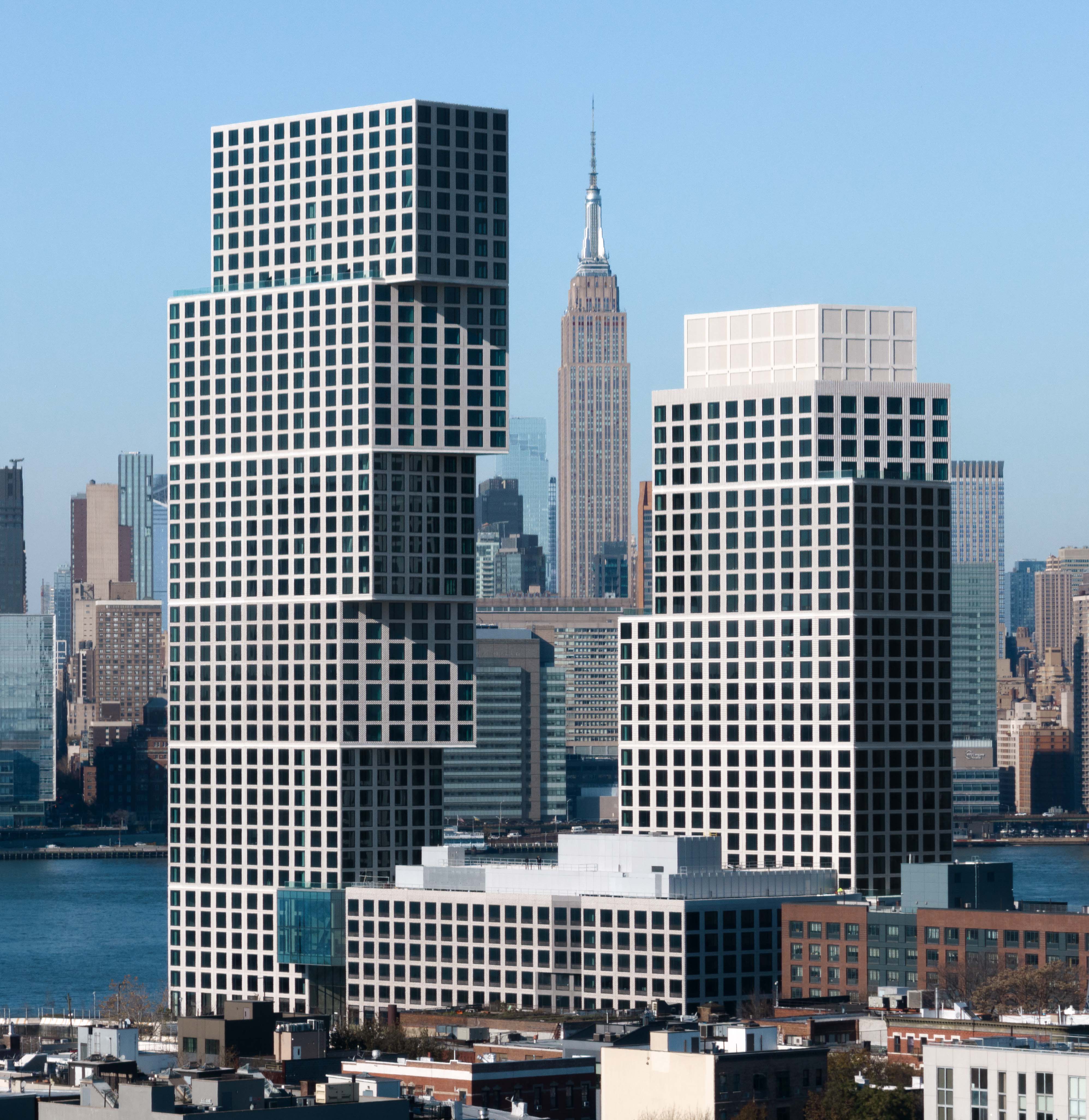
设计单位 OMA New York
项目地点 美国纽约布鲁克林
建筑面积 79,970平方米
建成时间 2022年7月
本文英文原文由设计单位提供。
绿点区位于布鲁克林的最北端,纽敦支流与东河交汇处。这个时而被称作“小波兰”的街区曾由低层的联排别墅组成,工业区被布置在街区的滨水一侧。因容纳了造船、制绳等产业,以及如石化等颇具污染性的工业活动,工业区通过东河与周边的地区进行区隔。
Greenpoint lies at the northernmost tip of Brooklyn where Newtown Creek meets the East River. The neighborhood—sometimes called “Little Poland”—has historically consisted of low-rise townhouses with industry at its waterfront edges. The industrial border, which included shipbuilding, rope-making, and more toxic activities such as petroleum refinement, cut the neighborhood off from the East River.



作为2005年对绿点区和威廉斯堡的全面规划的一部分,项目场地及其南北两侧的街区被定义为一个新的高密度住宅区。这里将建造一对塔楼,高度分别为30层与40层,其中既有商品房,也有占据总量三成的经济适用房。
As part of a sweeping rezoning of both Greenpoint and Williamsburg in 2005, our site and blocks to the north and south were identified as an area for new residential density—introducing pairs of thirty and forty-story towers to include market-rate and affordable housing (30 percent of units to be affordable).



新的开发项目将促进东河及其沿岸间的交流。场地位于绿点区主网格和垂直于纽敦支流延伸的次网格的交汇处。这个交汇点虽然提供了曼哈顿的全景,但也将场地的西端切出一个角,使整体成为梯形轮廓,也限制了地块的大小。如何在一个看起来十分局促的场地及街区中容纳数量不低的住房要求,成为此次设计中所面临的挑战。
In exchange, this new development would open access to and along the East River. Our site sits at the conjunction of Greenpoint’s primary grid and a secondary grid that extends perpendicular to Newtown Creek. This hinge point provides panoramic views of Manhattan, but also cuts the western end of the site, creating a trapezoidal outline and constraining the size of the block. Our challenge was to fit the desired amount of housing into a site and a neighborhood that both seemed too small to accommodate it.



分区控规中允许的最大楼面面积为11,000平方英尺(1022平方米)。我们很快发现,建筑的规模需要和要求的退让距离导致设计的两座塔楼间只有40英尺(12米)的距离。这样极窄的距离不仅破坏了场地的潜力,也成为邻里间的一道阻隔。我们缩减它们的占地面积,提供了60英尺(18米)的开放空间,更接近于典型街道的尺度。我们进而策略性地对塔楼形态进行扩展与收缩,以使每个塔楼中的空间效率最大化。
The zoning allowed for a maximum floorplate of 11,000 square feet. We quickly found that this scale and required setbacks would result in only 40 feet of separation between our two towers—an uncomfortable proximity that undermined the potential of the site and would create a wall from the neighborhood. We began by reducing their footprints to allow for 60 feet of open space, more akin to the scale of a typical street. We could then strategically expand and contract the towers for zones of maximum efficiency within each.



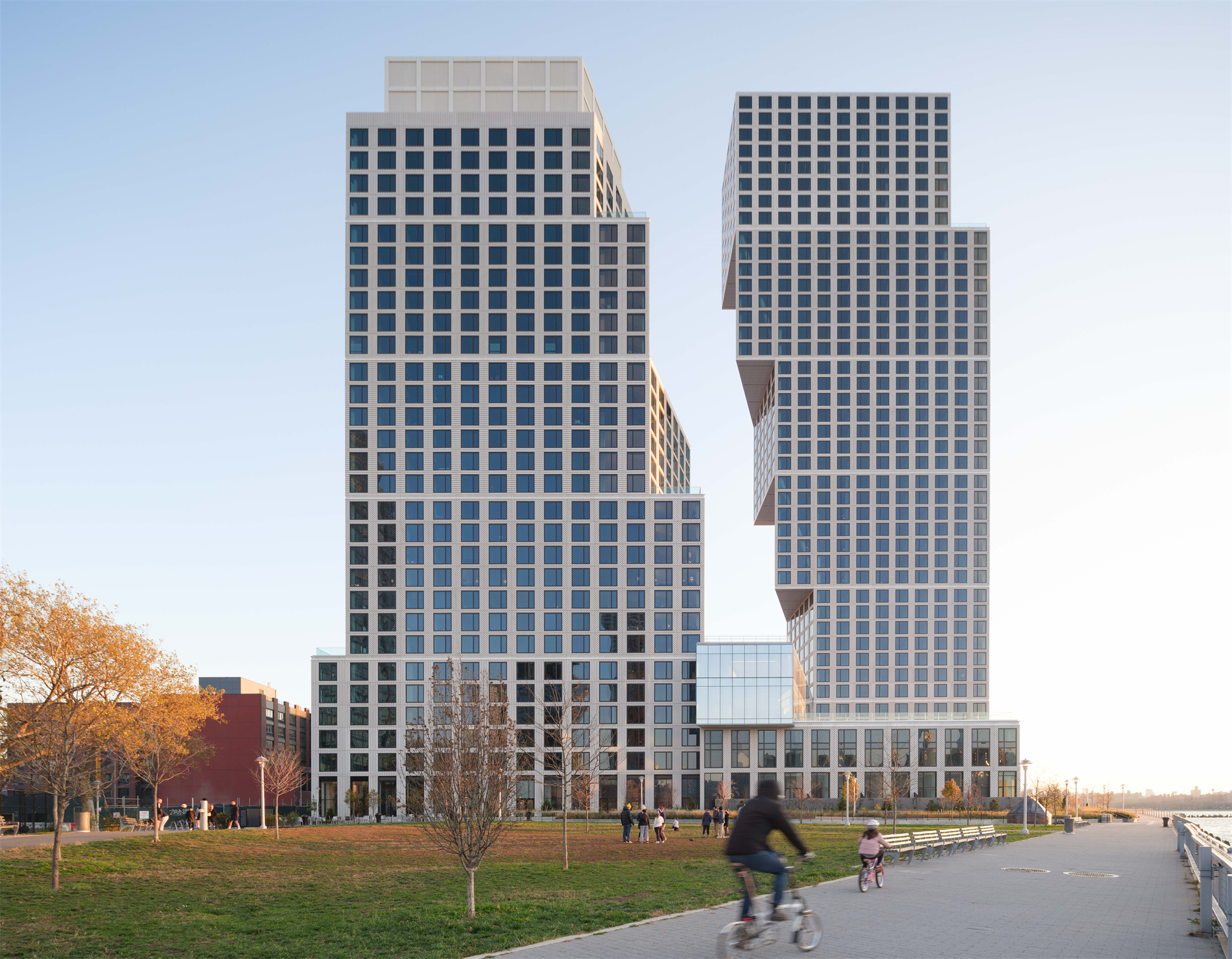
两座塔楼同时向内外两侧倾斜。较高的一栋在上升过程中向东扩张,以将楼内视野最大化,并为周边社区提供了一个戏剧性的形象。较矮的一栋更像是较高一栋的“孪生兄弟”,面向北部的新的滨水公园,朝地面侧不断扩大。
The two towers simultaneously lean into and away from one another. The taller tower widens toward the east as it rises, maximizing views and creating a dramatic face to the neighborhood. The shorter tower, a fraternal twin, widens toward the ground to face a new waterfront park to the north.






塔楼的造型也带来了露台和悬挑,设计强化了两者间的关系,让两栋塔楼看起来更像是源于一个整体。两栋塔楼呈现出正反“金字塔”的形状,它们之间的空隙,既富含变化,也能看出整体的紧密联系。塔楼以七至八层为一组,组成阶梯状的整体造型,这一形式同建筑外墙的衔接方式,调和两座塔楼和现有街区之间不可避免的尺度冲突。
The two towers are shaped to create terraces and overhangs that emphatically link them together as if they were broken apart from a single block. A ziggurat and its inverse, the pair are distinct yet intimately connected by the void between them. The stepped forms of the towers and the articulation of their facades mediate the inevitable contrast in scale between the two towers and the existing neighborhood. The stepping divides the tower into seven- to eight- story blocks that echo the scale of the neighboring buildings. The facade reinforces this subdivision.



外立面的设计更是加强了这种细分感。Avery玻璃幕墙兴起于旧金山,我们在这次纽约的项目中则希望让建筑给人以坚固的印象。我们将8英尺(2.4米)见方的大窗户整合到预制混凝土的网格中,既保持了广阔的视野,又简化和协调了住宅单元内部和外墙间的交接关系。这种坚固的形象也使建筑更好地跟周边环境融合在一起。
While The Avery’s glass curtain wall was rising in San Francisco, our proposal here sought to embrace solidity. Incorporating large 8-foot-by-8-foot windows into a grid of precast concrete maintains expansive views while making the complex negotiations between unit interiors and facade easier to accommodate. The solidity also creates a set of buildings that emerge more seamlessly from the neighborhood.
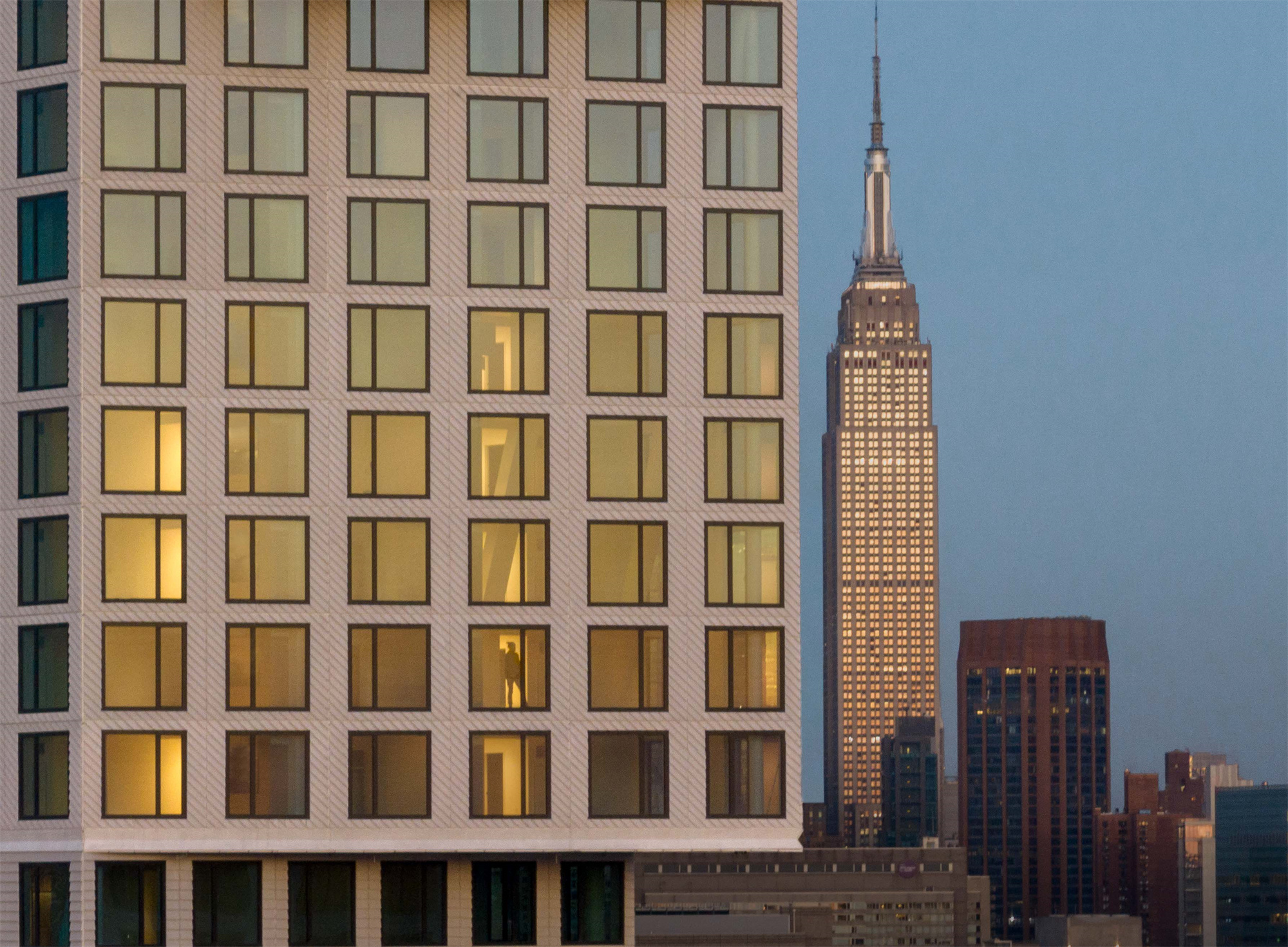



我们在预制板立面上雕刻出一系列倾斜的面,手法和绿点区联排别墅上的外墙瓦片如出一辙。塔楼交错的体块上,立面粼粼的纹理强调了比建筑体块更细致一层的尺度,并在一天之中随太阳的移动而变化,创造出具有动态感的浮雕。
Much like the shingled facades seen on Greenpoint’s townhouses, the precast panels are carved by a series of angled planes. The shingling of each “block” of the tower alternates in orientation to emphasize the finer scale of the towers’ mass—a dynamic relief that reacts to the movement of the sun.


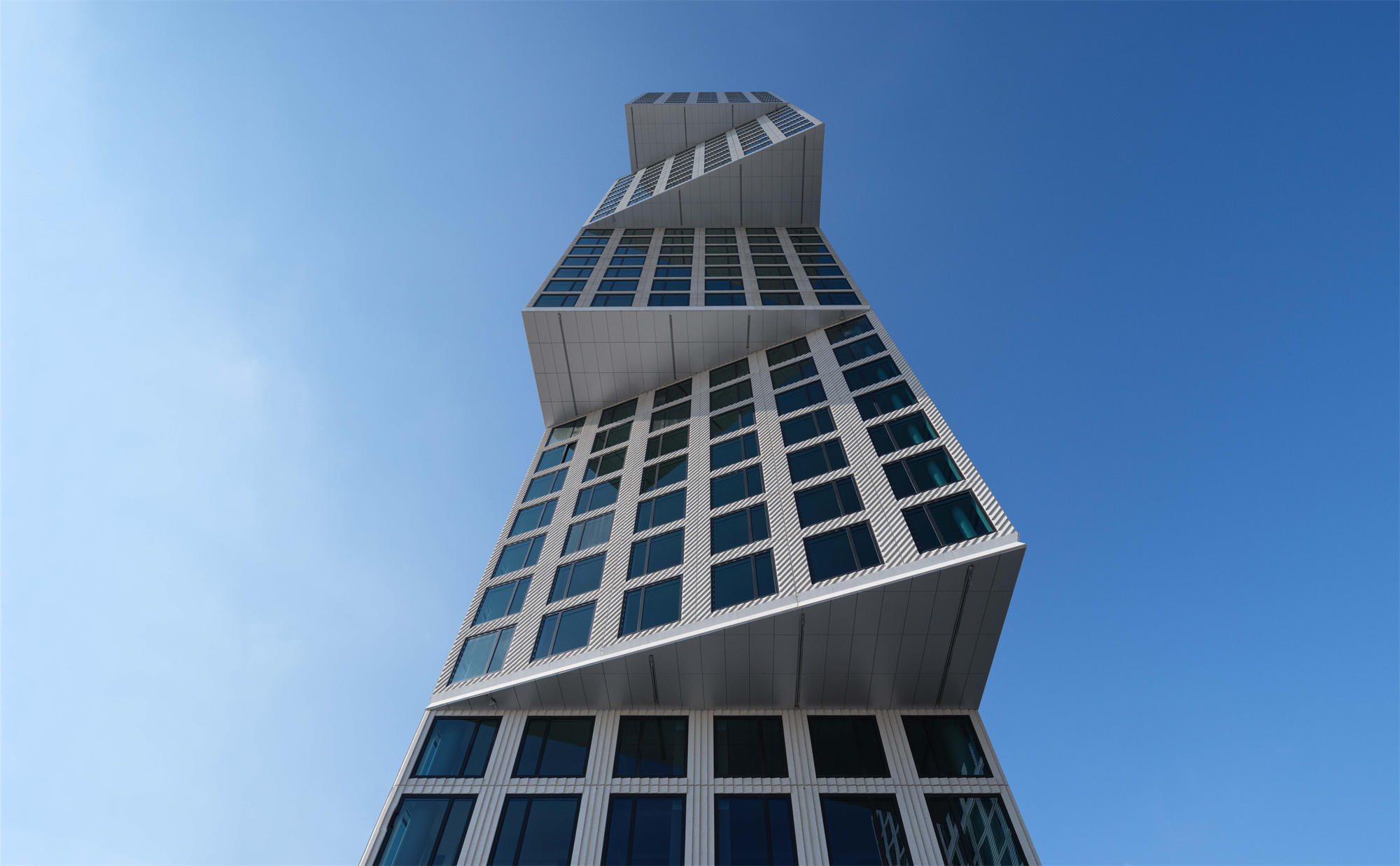

滨水塔楼的设计试图最大化朝向水面的视野,并在天际线中建立一个独特的、甚至是标志性的正立面形象。这样的设计构想往往意味着塔楼主体将背对社区,两者间更显疏离,与整体环境格格不入。在这次的设计,一组悬臂面将面向东边的绿点区,使建筑从基座上延伸出48英尺(15米),向附近的居民也展示出最引人注目的正面形象。
Waterfront towers typically try to both maximize the views to the water and establish a distinct, even iconic frontage within the skyline. Too often that means turning away from the neighborhood, creating a “back” side and disengaging the tower from its context. Here, a set of cantilevers—extending the building 48 feet from its base—faces east toward Greenpoint and presents our most dramatic facade to the neighborhood.



为了呼应绿点区曾作为家庭农场的街区起源,塔楼中设置了两层向滨水区开放的绿色空间。露台被一系列的公共空间所包围,在其上方,两座塔楼通过一座交通廊桥连接,可在这里看到曼哈顿的天际线。总而言之,本案旨在建立一个生活平台,让过去和未来、室内和室外、城市街景和滨水区相连。
Echoing Greenpoint’s pastoral origins as a neighborhood of family farms, two levels of green space open to the waterfront. Terraces are framed by a collection of common spaces. Above them, the towers are linked by an amenity bridge looking over the Manhattan skyline. Altogether, Greenpoint Landing aims to be a platform for living: connecting past and future, indoor and outdoor, urban streetscape and waterfront.






设计图纸 ▽




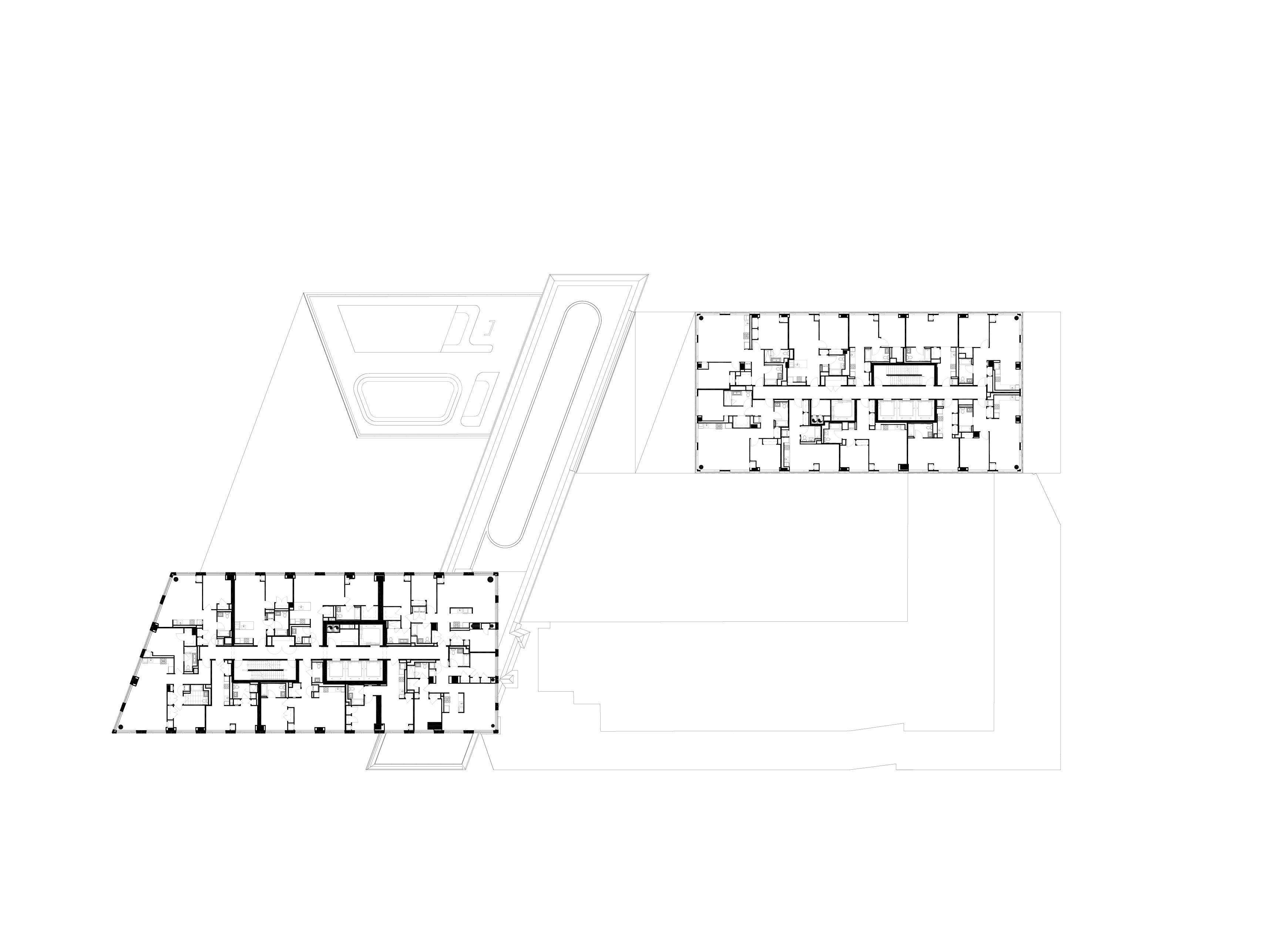


完整项目信息
Lead Design Architect: OMA New York
Partner-in-Charge: Jason Long
Project Architects: Yusef Ali Dennis, Christine Yoon
Team: Remy Bertin, Jingyi Bi, Sam Biroscak, Titouan Chapouly, Ken Chongsuwat, Marie-Claude Fares, Yashar Ghasemkhani, Anders Grinde, Wesley LeForce, Chong Ying Pai, Nathan Petty, Andres Rabano, Laylee Salek, Alan Song, Wo Hong Wu, Soojung Yoo, Steven Young, Juan Pablo Zepeda
Executive Architect: Beyer Blinder Belle Architects & Planners LLP
Unit Interior Designer: Beyer Blinder Belle Architects & Planners LLP
Landscape Architect (Waterfront): James Corner Field Operations
Landscape Architect (Building): Marmol Radziner
Amenities Interior Designer: Marmol Radziner
Structure: DeSimone Consulting Engineers
MEP and LEED: Cosentini Associates
Façade: Thornton Tomasetti
Lighting: Focus Lighting
Acoustics: Cerami Associates
Civil: Langan Engineering
Wayfinding and Signage: MTWTF
Marine Engineering: McLaren Engineering Group
版权声明:本文由OMA授权发布。欢迎转发,禁止以有方编辑版本转载。
投稿邮箱:media@archiposition.com
上一篇:杭州英蓝中心 / ARQ建筑事务所+Farrells法雷尔
下一篇:长廊方院:张家港精神文明建设研究与交流中心 / 上海实现建筑设计事务所